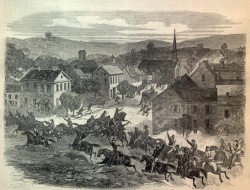Portal:Federalism and Democracy
Federalism and Democracy
|
America became a federal republic in 1787 when the Constitution was ratified. "Republic", as we use the word, is "a government in which supreme power resides in a body of citizens entitled to vote and is exercised by elected officers and representatives responsible to them and governing according to law."[1]. It can be more succinctly called a Representative Democracy. In our context, Federalism is "the principle of a federal union between the American colonies after the Revolution and of the formation and adoption of a constitution."[1] And, in case you wonder, "federal" is "of or relating to a state formed by the consolidation of several states which retain limited residuary powers of government under the common sovereignty of the new state."[1] There are other definitions of these terms, but these are the definitions that apply to the United States of America. America was not the first constitutional republic, but it was quite new in important ways. It drew on examples that came before it and on a variety of liberal thought that had existed in Europe (going back to Aristotle) and in America. It drew heavily on the English examples of constitutional monarchy, the English Constitution, and Common Law (which dates to King Henry II in about 1135). America's founders were
|
 Morgan's Raiders entering Washington, Ohio in August, 1863 |
CategoriesClick on arrows to see subcategories and articles. no pages or subcategories Things you can doHere are some things you can do:
|
TBD
Articles |